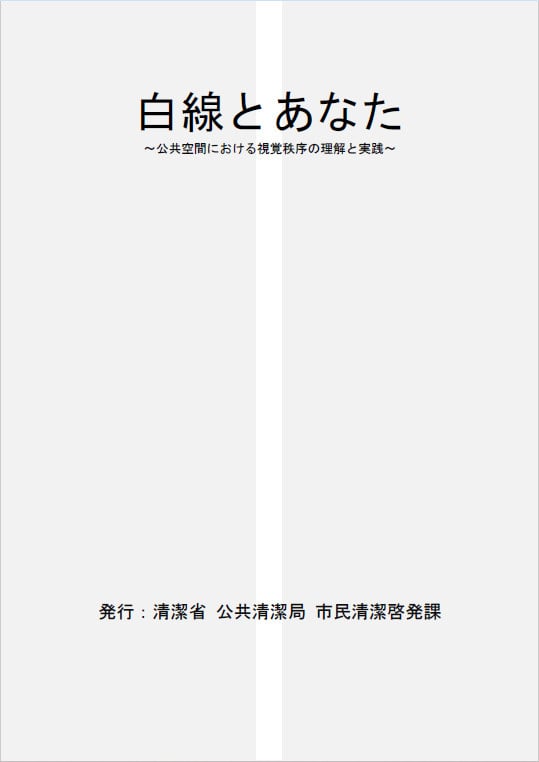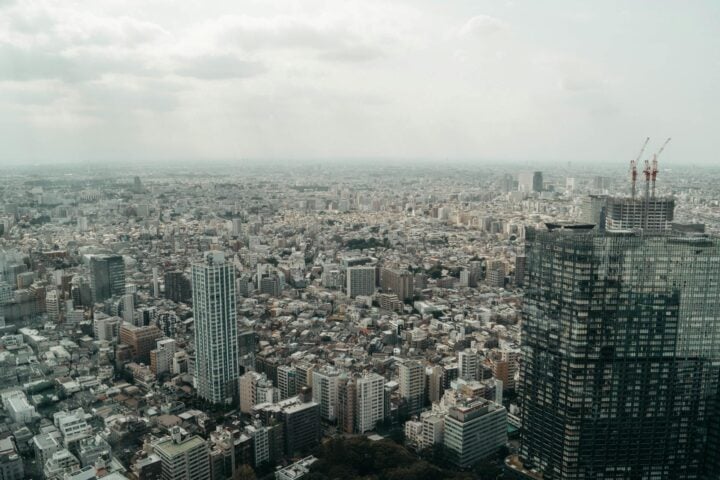Prologue
The first time I accompanied the White Line Division on their operation was at 2 a.m. at Shinjuku Station. Passing through the dimly lit ticket gates and walking through the deserted station, I found a security guard standing in front of an emergency door on the second basement floor. Without a word, I handed over my ID card. He glanced at it and let out a deep sigh.
“…You again.”
With those words, the guard unlocked the gate with his terminal and silently opened the door. I gave a slight nod and stepped into the corridor beyond.
Under the dim lighting, the head of the White Line Division, Kiyoshi Shiraishi, was waiting. Carrying a commercial-grade high-pressure washer on his shoulder and holding a white line color sample book in his hand, he looked like a soldier heading to the battlefield.
“Still getting clearance, huh? With that circus you write for.”
He didn’t even wait for a hello. Just gave me that familiar look, half amused, half resigned. I smiled and brushed it off, taking a recorder out of my pocket.
That day, I would witness the entirety of “Operation: Featherstorm.” It all started with an envelope that arrived at the Tokyo Tofu Tribune editorial office. Inside was a document titled “White Line Maintenance Manual, 47th Edition” and a note that read: “The white line is no longer white.”
Introduction: The Daily Life and Mission of the White Line Division
The Public Cleanliness Bureau is a specialized agency under the Ministry of Sanitation and Order, established to maintain the “visual order” of urban spaces. Among its divisions, the most field-oriented is the “White Line Division.”
The mission of the White Line Division is straightforward: to keep the white lines drawn on station platforms at or above the “National White Standard Index (NWSI).” The whiteness of the white lines symbolizes order and safety in public spaces and serves as a visual device to subconsciously adjust citizens’ “cleanliness awareness.”
Every morning at 3 a.m., before the first train starts running, the staff of the White Line Division scatter throughout the station premises to check the condition of the white lines and perform repainting, cleaning, and gloss correction as needed. All tasks are carried out based on the “White Line Maintenance Manual, 47th Edition,” which sets 27 KPIs, including whiteness per square centimeter, straightness, and edge smoothness.
Chief Shiraishi, the most senior member of the White Line Division, often says, “When the white line clouds, the nation clouds.” His obsession with the white line borders on faith.
“The white line is not just a line. It’s a boundary between order and chaos.”
That day, he crouched at the edge of the white line, measuring the reflection angle of its gloss, and quietly muttered these words.
The Emergence of an Anomaly: The Pigeon Bombing
The White Line Division noticed something unusual late last month. On Platform 3 of Shinjuku Station, near the center of the white line, “spot-like contamination” was observed daily. Initially thought to be footprints of passersby, analysis revealed it to be pigeon droppings.
“Natural contamination has a low removal priority. But this is clearly ‘intentional.'”
Chief Shiraishi focused on the “arrangement pattern” of the droppings on the white line. It seemed as if they were trying to convey something, aligned at regular intervals.
According to an internal notice from the Public Cleanliness Bureau, this “continuous bombing” occurred at 17 locations over five days, causing the Cleanliness Performance Index (CPI) to plummet. The Ministry of Sanitation and Order issued a “warning regarding the delayed response of the White Line Division.”
But that wasn’t the only problem. The daily work records submitted by the White Line Division, known as “CIR-47 (Cleanliness Incident Report ver.47),” contained no contamination records for the affected areas.
“The logs have been erased. Someone is trying to make the white line’s dirt ‘disappear.'”
Chief Shiraishi contacted the Microparticle Management Room, but the issue was dismissed as “natural contamination is not subject to logging,” and the investigation was terminated. The Urban Gaps Room outright refused to cooperate, stating, “Pigeon flight paths do not fall under ‘urban gaps.'”
Isolated, the White Line Division began their own investigation. One night, surveillance cameras captured a pigeon walking precisely along the white line and dropping its feces.
The pigeon had a small tag on its leg. The tag read: “Who is cleanliness for?”
Countermeasures: Operation: Featherstorm
The White Line Division devised their own “anti-pigeon strategy.” The operation was named “Operation: Featherstorm.” Its sole purpose was to make the white line white again.
The operation began at 2 a.m., coinciding with the complete lockdown of Shinjuku Station. The staff of the White Line Division, equipped with commercial-grade high-pressure washers, white line repainting kits, and “visual order correction LED lights,” deployed to the site.
“This is not cleaning. This is the reconstruction of order.”
Chief Shiraishi said this during the pre-operation briefing. Behind him was the operation map of the White Line Division. It marked the “bombing patterns” of the pigeons in red marker, with “Source of Contamination: Unidentified” written prominently in the center.
Just before the operation began, the White Line Division requested support from the Microparticle Management Room. However, a disagreement over the particle size of the cleaning agent led to a standoff.
“If the particle size exceeds 0.3μm, it will affect the gloss of the white line.” “But anything smaller won’t address the protein contamination from the pigeons.”
The debate continued past 1 a.m., and Chief Shiraishi ultimately issued a cryptic directive: “Choose particles with soul.” The White Line Division decided to use their own custom-formulated cleaning agent.
To identify the pigeons’ hiding routes, the White Line Division sought cooperation from the Urban Gaps Room. However, their response was succinct: “Again, pigeons belong to ‘space,’ not ‘gaps.'”
With this single sentence, the Urban Gaps Room completely withdrew from the operation. Muttering, “What’s the difference between space and gaps…,” Chief Shiraishi decided to personally crawl into the ceiling inspection hatch.
Execution of the Operation
At 2:30 a.m., the White Line Division commenced the operation. The station lights were dimmed, and the white light of the LED lamps illuminated the white lines. The staff began cleaning in silence, while Chief Shiraishi crawled through the ceiling, searching for the pigeons’ nest.
At 3:12 a.m., Chief Shiraishi reached an “abnormal space.” There, he found a nest where tagged pigeons were neatly lined up asleep, along with a file placed beside them.
The cover of the file read: “CPI Manipulation Manual (Confidential Draft)” Issued by: Ministry of Sanitation and Order, KPI Strategy Office
The Battle to Protect the White Line
It detailed the deliberate manipulation of CPI figures within the Ministry of Sanitation and Order, stated:
“By keeping the frequency of visual contamination below a certain threshold, citizens’ cleanliness awareness can be maintained in a state of ‘moderate tension.’ Complete cleanliness leads to the collapse of the system.” In other words, the white line must not be too white. By leaving “slight dirt,” citizens’ anxiety and attentiveness can be maintained, preserving the system’s raison d’être—this was the logic of the upper echelons.
Furthermore, the manual concluded: “Budget allocations for the following fiscal year are automatically redistributed based on CPI fluctuations. Signs of ‘appropriate contamination’ are necessary to secure the budget.”
The efforts of the White Line Division were not only “futile” but were being used as a “performance” for budget manipulation.
Chief Shiraishi stood silently for a while, holding the file. Eventually, he took out his radio and issued an order to all White Line Division staff: “Abort the operation. The white line doesn’t need to be white.”
The staff murmured briefly but did not resist. It was the first time Chief Shiraishi had ever issued an order to “not whiten the white line.”
But he didn’t stop there. At 4:12 a.m., Chief Shiraishi recorded the following in CIR-47: “Today, the white line was completely white. However, it should not be recorded.” He then refused to submit CIR-47. This was a serious violation considered “dereliction of duty” under the White Line Division’s regulations.
By the time the first train started running the next morning, the white line on Platform 3 of Shinjuku Station shone with a pristine whiteness, as if brand new. However, Chief Shiraishi was nowhere to be found. His ID card was reportedly left on the white line within the station premises.
Who Is the White Line’s Whiteness For?
Three days after Chief Shiraishi’s disappearance, the Ministry of Sanitation and Order issued an official statement: “The White Line Division is disbanded as of today, and all its operations will henceforth be automated by AWML (Autonomous White Line Maintenance Logic). We will continue to provide citizens with safe and secure white lines.”
In the station premises, new automatic white line correction devices had already begun operating. The whiteness of the white lines was more uniform and somewhat inorganic. However, no one seemed to notice the difference.
The Envelope Sent to the Editorial Office
That weekend, another envelope arrived at the Tokyo Tofu Tribune editorial office. The sender was unknown. Inside were papers labeled “Unsubmitted CIR-47” and a photograph.
The photo showed an ID card placed on the white line, with a pigeon standing next to it. The pigeon had the same tag on its leg.
“Who is cleanliness for?”
Even now, I remember the whiteness of that white line. It was perfect. But it felt unnatural. As if it had been painted white to cover up someone’s existence.
Chief Shiraishi didn’t try to protect the white line. He tried to protect the meaning of the white line. The white line is not just a line. It is the boundary between order and chaos, and it only exists because someone stands there.
Now, no one stands at that boundary. The white line is white. But that means someone has been erased.
Leaked Document: “The White Line and You”
Tokyo Tofu Tribune has obtained a citizen-facing pamphlet issued by the Ministry of Sanitation and Order. Titled “白線とあなた” (The White Line and You), the document outlines behavioral expectations regarding public white lines. While the full text is in Japanese, the tone, formatting, and illustrations speak volumes.





